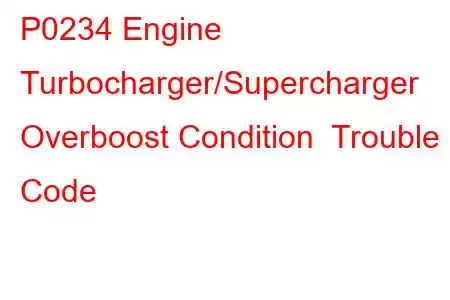P0234 Turbocharger / Supercharger "A" Overboost Condition Code
OBD-II Trouble Code Technical Description
Turbocharger / Supercharger "A" Overboost Condition
What does that mean?
This diagnostic trouble code (DTC) is a generic powertrain code. It is considered generic because it applies to all makes and models of vehicles (1996-newer), although specific repair steps may be slightly different depending on the model.
Trouble code P0234 indicates the powertrain control module (PCM) senses a dangerously high boost pressure from the engine's forced induction system. Levels of boost in excess of recommended levels can compromise the structural integrity of the engine.
Normally, an engine relies on the vacuum produced by the downward movement of the piston to draw the air and fuel charge into the engine. A supercharger or turbocharger is an air compressor used to increase the air and fuel charge entering the engine. This is known as "forced induction" which allows a much smaller fuel-efficient engine to create the power normally available with a much larger engine.
The mechanical apparatus used in forced induction is divided into three categories, positive displacement (roots style), centrifugal and turbo. The roots style and centrifugal chargers are belt driven while the turbo relies on pressure from the exhaust to operate.
A roots or positive displacement supercharger is positioned on the top of the intake. A centrifugal looks much like a rotary air conditioning compressor and is located on the driver's side front of the engine. Turbochargers are located in line with the exhaust system.
As boost pressure rises, the stress on the engine increases as well. Your engine has recommended boost pressure limits to preclude the possibility of engine component failure. Code P0234 is set when these limits are breached and should be corrected as soon as possible to prevent engine or transmission damage.
Turbo chargers rely on exhaust pressure to spin the turbine blades fast enough to produce air pressure greater than atmospheric. However they have an inherent lag where the exhaust pressure is insufficient to spin the turbo fast enough to create pressure. Depending on the type of unit used, the turbo needs 1700 to 2500 engine rpm before it begins to "spool up."
Turbos spin around 250,000 rpm in full boost. Boost pressure increases with engine rpm. To regulate the boost pressure and prevent overboost, a wastegate valve is installed. Most modern turbos have an internal wastegate and external actuator. There is a rod from the actuator to the wastegate on the turbo. Intake manifold air pressure passes to the top of the wastegate. As boost pressure increases it begins to exert force on the spring in the actuator that holds the wastegate valve closed. The higher the pressure rises, the more it overpowers the spring, resulting in the wastegate opening and directing exhaust gas away from the turbo blades and preventing further increase in boost.
Regulation of the pressure applied to the wastegate regulates the boost levels at specific rpm. To accomplish this, the computer uses barometric or MAP sensors, engine and transmission temperature sensors, knock sensors and intake pressure sensors to determine the amount of wastegate opening necessary to deliver the best boost levels.
To regulate boost levels, the computer uses either a solenoid, stepper motor or pulse modulator. By regulating the pressure to the wastegate actuator, varying degrees of boost are possible.
Symptoms
The symptoms displayed for a P0234 code will depend on the cause of the overboost condition:
The service engine soon or check engine light will illuminate. You will experience a loss of power. The engine may show signs of overheating. The transmission may show signs of overheating and harsh shifting. Additional codes associated with tRead: 52


